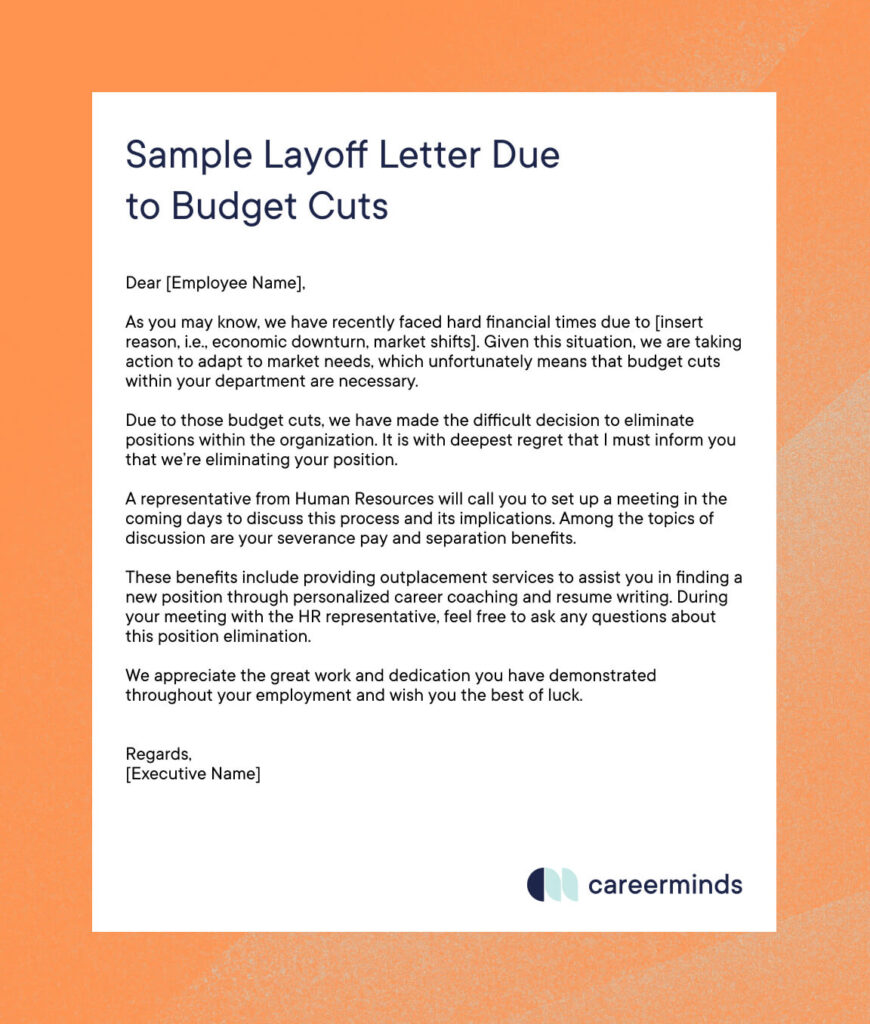
How to Write a Layoff Letter Due To Budget Cuts (Template Included)
May 07, 2025 Written by Rafael Spuldar

Preparing for a RIF?
Download our Essential Guide to Handling a Layoff
Request Pricing
Compare our rates to other providers
When companies face economic challenges, making difficult decisions such as implementing a reduction in force (RIF) is often necessary. When such reduction events are inevitable, a well-written layoff letter due to budget cuts is essential for handling this process with professionalism and care.
This article will walk you through how to draft a thoughtful employee layoff notice, outline its key components, and provide a ready-to-use sample template for you to get started.
How Do Budget Cuts Impact Layoffs?
As you know, budget cuts can occur due to various conditions, such as a shifting market, an economic downturn, or operational restructuring due to a merger or acquisition.
Layoffs are usually seen as a last resort after other cost-saving measures have been evaluated. Executives and HR typically assess all alternatives before laying staff off, including reduced hours or pay cuts.
However, these measures can damage morale and lead to the departure of top performers. If layoffs are unavoidable, HR must plan carefully to ensure legal compliance, clear communication, and sensitivity toward affected staff.
A structured approach to layoffs includes:
- Identifying which roles will be affected using fair and documented criteria.
- Reviewing legal obligations such as WARN Act notifications.
- Preparing severance agreements and benefit details.
- Coordinating communications to ensure consistency and support for all parties.
For some extra help in this process, click below to download our Careerminds essential guide to handling a layoff. It includes step-by-step strategies to make sure that you’re covered from the initial layoff selection process to offboarding, severance agreements, and outplacement support.

How Do You Write a Layoff Letter Due to Budget Cuts?
A layoff letter should be clear, concise, and respectful. It’s not easy to deliver this kind of news, but a consistent, compassionate employee downsizing notification process can soften the impact for affected staff. The goal is to inform employees that the termination is due to organizational financial needs, not performance issues.
Here are some basic tips on how to write a layoff letter:
| Layoff Letter Writing Guidelines | |
| Step: | Purpose: |
| Be direct. | Clearly state that the termination is due to budget cuts. |
| Stay professional. | Avoid emotional or accusatory language. |
| Offer support. | Mention severance, benefits, and outplacement resources. |
| Remain compliant. | Ensure your notice complies with all applicable labor laws (e.g., WARN Act). |
Another tool to help you in this process is our easy-to-use layoff script. It provides five steps to help you prepare for this tough event and handle it with total empathy and professionalism. Click below to download your free copy of our layoff script.
Sample Layoff Letter Due to Budget Cuts
To further help guide you through this challenging process, we’ve included a sample layoff letter due to budget cuts below. This example demonstrates the best practices for tone, structure, and content, while incorporating helpful elements like severance and benefits support.
Feel free to adapt this sample reduction in force letter to your organization’s specific situation:
Copyable example:
Dear [Employee Name],
As you may know, we have recently faced hard financial times due to [insert reason, i.e., economic downturn, market shifts]. Given this situation, we are taking action to adapt to market needs, which unfortunately means that budget cuts within your department are necessary.
Due to those budget cuts, we have made the difficult decision to eliminate positions within the organization. It is with deepest regret that I must inform you that we’re eliminating your position.
A representative from Human Resources will call you to set up a meeting in the coming days to discuss this process and its implications. Among the topics of discussion are your severance pay and separation benefits.
These benefits include providing outplacement services to assist you in finding a new position through personalized career coaching and resume writing. During your meeting with the HR representative, feel free to ask any questions about this position elimination.
We appreciate the great work and dedication you have demonstrated throughout your employment and wish you the best of luck.
Regards,
[Executive Name]
What Should Be Included in a Layoff Notice Due to Budget Cuts?
Now let’s break down this sample layoff letter due to budget cuts into its key components. Creating a comprehensive termination letter is crucial to maintaining transparency and professionalism during a RIF event. Each section of the employee layoff notice should serve a purpose, guiding the employee through the transition process with empathy and clarity.
Here’s what your layoff letter due to budget cuts should include:
Introduction
The introduction should immediately address the employee by name and state the letter’s purpose. It is essential to be clear from the start and avoid ambiguity. Softening the message too much can lead to confusion or misinterpretation.
Reason for the Layoff
After the initial statement, it’s important to provide some background about the situation that’s led to the layoff. This includes being transparent about why the organization is making budget cuts. Avoid assigning blame and focus on the organizational factors at play.
Termination Details
This part of the employee layoff notice formally states that the employee’s position is being eliminated. Keep this section straightforward and free of unnecessary emotion. Clarity helps the employee understand that the decision is final and unrelated to their performance.
Benefits Overview
Letting the employee know that they have access to post-employment support is critical. While you don’t need to outline every detail, it’s helpful to mention that a meeting will follow to discuss their severance, benefits, and available outplacement support. This helps ease any uncertainty and stress.
Sign-Off
Conclude your reduction in force letter with a brief but sincere message of appreciation. Acknowledge the employee’s contributions without overexplaining. A simple, gracious farewell helps maintain goodwill and ensures that the letter’s tone remains professional and respectful.
Additional Questions About Layoffs Due to Budget Cuts
How Much Notice Is Required for Layoffs Due to Budget Cuts?
Notice requirements depend on your jurisdiction. In the US, the WARN Act mandates a 60-day notice to employees for large-scale layoffs. Smaller organizations may follow state-level rules or internal policies.
Here are some useful tips to remember:
- Check local labor laws carefully to ensure your organization complies with all relevant local, state, and federal regulations.
- Communicate early and clearly with all affected parties to avoid confusion, build trust, and provide sufficient preparation time.
- Document all notices, including dates and delivery methods, to protect your organization from legal risks or misunderstandings.
No federal law requires severance, but offering it can improve morale, reduce legal risk, and help impacted employees transition more smoothly. So, in your termination letter, it’s best to outline the severance offer clearly.
Severance packages may include:
- A tenure-based payment that acknowledges the individual’s efforts as an employee and provides extra financial stability during the transition period.
- COBRA continuation assistance to ensure ongoing access to health insurance while the laid-off employee secures alternative coverage.
- Career transition services, such as outplacement, help the employee find a new opportunity through job search coaching, resume writing, and networking guidance.
Layoff Letters Due to Budget Cuts: Final Thoughts
A well-written layoff letter due to budget cuts demonstrates that your organization values its employees, even during tough times. By addressing the situation directly, explaining the reasoning behind it, and offering support, you will show empathy and maintain professionalism.
Every downsizing notification or reduction in force letter should be treated with legal and empathetic care. The structure and sample letter provided above ensure that both needs are met with clarity and respect. For HR leaders, being prepared with a structured budget reduction communication plan saves time and reduces stress in a challenging situation.
If you need more help navigating layoffs due to budget cuts or any other workforce reduction event, Careerminds is here for you. Our resources, templates, guides, and industry-leading outplacement services will help you navigate those complicated processes. Click below to reach out to our experts and see if we’re the right partner for your organization.
In need of outplacement assistance?
At Careerminds, we care about people first. That’s why we offer personalized talent management solutions for every level at lower costs, globally.



